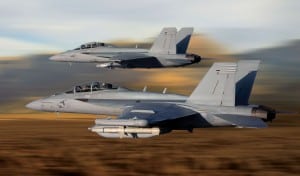Navy officials recently said the future F/A-XX aircraft will be the “quarterback” of a carrier-based manned-unmanned aircraft teaming concept in the future aircraft carrier-based Next Generation Air Dominance (NGAD) aircraft concept.
F/A-XX is set to be the sixth-generation fighter aircraft for the Navy that will, in part, replace the F/A-18E/F aircraft in the 2030s as they reach the end of their service lives. The Navy sees it as tied to the Manned-Unmanned Teaming (MUM-T) concept in the future force that will combine both kinds of assets.
“The Navy continues to accelerate development of the NGAD [Family of Systems, FoS] to provide advanced, carrier-based power projection capabilities that extend the range of our carriers,” the Navy Department’s acquisition officials said in a written joint statement presented to the House Armed Services Committee subcommittee on tactical air and land forces for a hearing on April 27.
The statement was issued jointly for the committee by Jay Stefany, performing the duties of the Assistant Secretary of the Navy for Research, Development, and Acquisition (ASN/RDA); Rear Adm. Andrew Loiselle, Director of the Air Warfare Division (OPNAV/N98); and Lt. Gen. Mark Wise, Marine Corps Deputy Commandant for Aviation.

“ F/A-XX is the strike fighter component of the NGAD FoS that will be the ‘Quarterback’ of the MUM-T concept, directing multiple tactical platforms at the leading edge of the battlespace,” the officials continued.
The officials said the Navy started the concept refinement phase of F/A-XX in fiscal year 2021 and “it remains on schedule,” with the government collaborating with undisclosed industry teams to develop vendor concepts to balance air dominance capabilities with long-term affordability.
The Navy’s FY 2023 budget request has kept finding levels for NGAD secret now for three years running.
When initial budget documents were released in March, Rear Adm. John Gumbleton, Deputy Assistant Secretary of the Navy for Budget, said NGAD is a classified program and “funding increase is going up also over the [five year Future Years Defense Program, FYDP], but we are choosing to keep that value classified (Defense Daily, March 28).
Gumbleton did disclose investment in NGAD are set to increase over the FYDP “somewhat dramatically.”
The last time the Navy disclosed the NGAD budget was in the FY ‘20 request when it directed $20.7 million that year and projected spending $256 million in FY ‘22.
This is in contrast to the Air Force’s similar NGAD program, which retains public funding levels. The Air Force FY ‘23 budget request is seeking almost $1.7 billion for NGAD under the research and development account.
Last year, Navy officials said NGAD would likely be a manned fighter, but the service is pushing the future air wings to get upward of 50 percent unmanned, with integration of MUM-T approached.
At the time, Rear Adm. Gregory Harris, then-Director of the Air Warfare Division, said the first increment of NGAD will replace the F/A-18E/F Super Hornets and the second increment will replace the EA-18G Growler. He said while the decision on whether F/A-XX would be manned or unmanned would be undecided for a few more years, he thought it would likely be manned (Defense Daily, March 30, 2021).
Harris said F/A-XX was more than just succeeding the Super Hornet, but leading the MUM-T concept with a family of adjunct unmanned air platforms that could focus on electronic warfare, early warning, or other uses.
The Navy’s 2021 Aviation Vision 2030-2035 Plan, released last October, said a combination of F-35C and F/A-XX aircraft will provide Navy tactical fighter aircraft capability and capacity within the carrier air wing as the Super Hornets start to retire in the 2030s.
“The advanced carrier-based power projection capabilities resident in F/A-XX will maintain [aircraft carrier] relevance in advanced threat environments,” the document said.
It noted analysis for F/A-XX shows it must have longer range and greater speed than the Super Hornets while also incorporating passive and active sensor technology “and possess the capability to employ the longer-range weapons programmed for the future.”
“These manned and unmanned aircraft plus attritable assets will be employed across domains to enable integrated kinetic and non-kinetic fires at tactically relevant ranges. As autonomy and [machine learning] efforts mature, the appropriate mix of F/A-XX, manned and unmanned platforms will be evaluated to ensure the most lethal and affordable [carrier air wing],” the vision plan added.